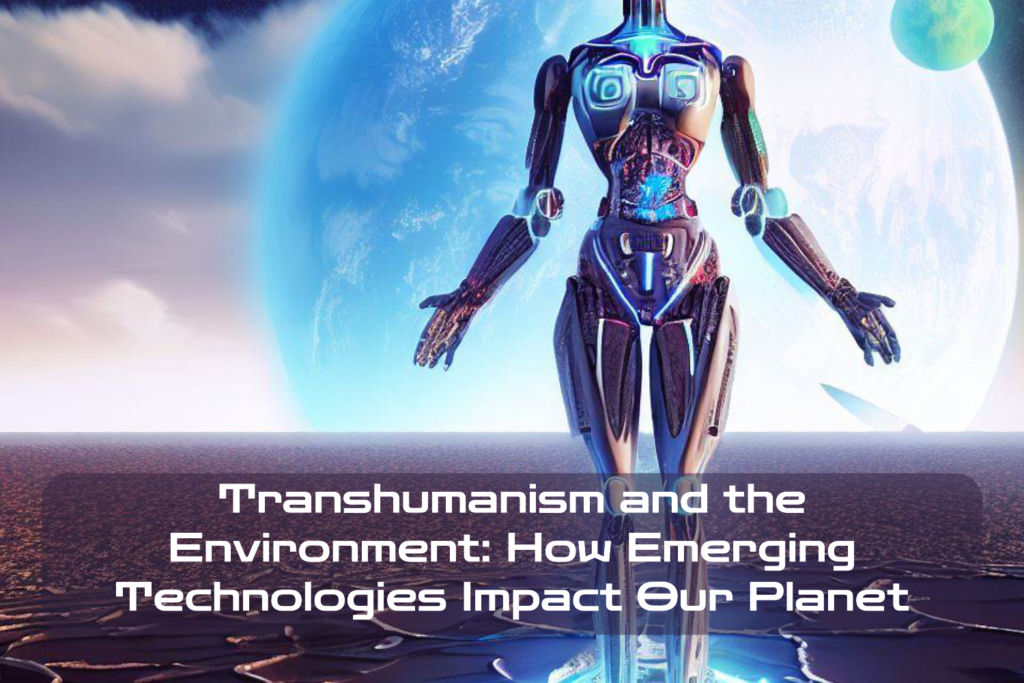Transhumanism is a movement that seeks to enhance human capabilities through the use of advanced technologies. These technologies include genetic engineering, nanotechnology, and artificial intelligence.
While transhumanism has the potential to improve human lives in many ways, it also raises important ethical and environmental concerns. In this article, we will explore how emerging technologies impact our planet.
Definition of Transhumanism
Transhumanism is a philosophical movement that advocates for the use of technology to enhance human capabilities. This can take many forms, including cognitive enhancements such as memory implants or physical enhancements such as prosthetic limbs.
The ultimate goal of transhumanism is to overcome human biological limitations and create a new species that is better adapted to its environment.
Overview of the impact of emerging technologies on the environment
Emerging technologies have the potential to transform our relationship with nature in both positive and negative ways.
On the one hand, technological advancements can help us mitigate environmental damage caused by human activity. For example, renewable energy sources like wind turbines and solar panels can reduce greenhouse gas emissions from fossil fuels.
Similarly, precision agriculture techniques enable farmers to optimize crop yields while minimizing their environmental impact.
On the other hand, emerging technologies can also have negative impacts on the environment.
For example, electronic waste generated by discarded devices poses a significant challenge for sustainable waste management. Furthermore, genetic engineering techniques pose a risk to biodiversity when they are used in an uncontrolled manner.
The intersection between transhumanism and environmental sustainability presents complex ethical challenges that require careful consideration.
The Benefits and Risks of Transhumanism on the Environment

Advantages of Emerging Technologies in Environmental Conservation
Transhumanism has the potential to revolutionize environmental conservation efforts through emerging technologies.
Renewable energy sources such as solar, wind, hydro and geothermal energy provide endless possibilities for a sustainable future. They have reduced carbon emissions, provided affordable electricity, and minimized the use of fossil fuels which have adverse effects on climate change.
Precision agriculture explores ways to improve agricultural productivity while minimizing environmental impact through better land management practices that conserve soil fertility and reduce pollution through innovative farming techniques.
Additionally, precision aquaculture technology helps farmers maintain better water quality by monitoring dissolved oxygen levels.
Transportation systems are also crucial factors in environmental conservation. Sustainable transportation systems like electric vehicles and public transport are known to significantly reduce greenhouse gas emissions compared to conventional cars.
Electric cars help lower carbon emissions while reducing noise pollution and air pollution caused by conventional cars. Public transport modes such as buses or trains can help reduce traffic congestion.
Negative Impacts of Transhumanism on the Environment
As much as transhumanism offers great advantages in environmental conservation efforts, it still poses significant risks to our planet’s health if not well managed.
Increased e-waste from technological advancements poses a severe threat to both human health and the environment; these hazardous materials contain toxic chemicals such as mercury, lead, and cadmium that pollute landfills when disposed of improperly.
Genetic engineering can lead to alterations that harm biodiversity by creating new species or eliminating others from their habitats, leading to ecological imbalances; hence, there is a need for proper regulations governing genetic engineering research before testing products on large scales.
Another danger of transhumanism is geoengineering, which entails manipulating natural systems like climate change by removing CO2 from the atmosphere or changing ocean chemistry levels with unknown long-term effects.
Potential for Genetic Engineering to Harm Biodiversity
Genetic engineering is the process of manipulating an organism’s genome to create new traits. This can be done using various techniques such as CRISPR/Cas9 gene editing, RNA interference, and transgenic engineering. While genetic engineering provides significant benefits in various sectors, it poses a risk to biodiversity if not controlled.
The manipulation of genomes raises ethical concerns about the loss of genetic diversity that could harm ecosystem stability; this could lead to species loss, ecological imbalance, or even extinction.
For instance, research has shown that genetically modified organisms (GMOs) have altered natural plant populations, causing reduced plant fitness and decreased biodiversity because they are programmed only to grow under specific conditions.
Moreover, transgenic crops can crossbreed with wild relatives, leading to uncontrolled hybridization that threatens natural ecosystems’ genetic diversity.
Regulatory measures such as monitoring the release of GMOs into the environment and establishing protocols for preventing accidental release will be essential in mitigating these risks.
Ethical Concerns Surrounding Geoengineering
Geoengineering refers to deliberate interventions in Earth’s systems to mitigate climate change’s negative effects; these interventions include carbon capture technology and solar radiation management.
While geoengineering has been touted as a potential solution for mitigating climate change effects, it raises ethical concerns about its adverse effects on natural ecosystems.
Carbon capture technology involves capturing CO2 from power plants or other industrial processes at source points, where it is then stored underground or repurposed for other use cases. The technology creates new environmental risks because carbon leakage from storage reservoirs increases CO2 concentrations in groundwater supplies, which causes severe public health issues.
Solar radiation management involves reflecting sunlight back into space by deploying reflective particles into the atmosphere; however, this approach interferes with weather patterns, leading to potential weather-related disasters like droughts or floods that affect both human and animal life negatively.
While transhumanism has the potential to revolutionize environmental conservation efforts, we must be mindful of its adverse impacts on our planet’s health.
Case Studies: How Emerging Technologies are Affecting Our Planet

CRISPR gene editing technology and its potential impact on ecosystems
CRISPR gene editing technology has the potential to revolutionize the way we approach genetic diseases, environmental conservation, and agriculture. However, with great power comes great responsibility.
The use of CRISPR in environmental management could be a double-edged sword; it could help eliminate invasive species or protect endangered ones, but it also poses a risk of disrupting ecosystems by altering genes in unintended ways. For instance, manipulating the genetic makeup of a target species could inadvertently change the dynamics of its interactions with other organisms in its environment.
The use of drones in environmental monitoring and conservation efforts
Drones equipped with cameras and sensors are becoming increasingly popular for environmental monitoring and conservation efforts. They can survey areas that may otherwise be difficult or dangerous to access, such as forests or oceans.
Drones can help detect illegal activities like poaching or deforestation, providing authorities with real-time information to take appropriate action. However, there are concerns about privacy rights and safety hazards associated with drone usage.
Blockchain technology for tracking sustainable supply chains
Blockchain technology is being used to ensure transparency and accountability in sustainable supply chains by tracking products from their origin to their final destination. This allows consumers to make informed choices about the products they buy based on their ethical values.
It can also help reduce waste by optimizing transportation routes and minimizing errors in inventory management. However, not all supply chain actors may be willing to adopt blockchain technology due to a lack of incentives or resistance to change.
Ethical Considerations Surrounding Transhumanism and the Environment

The role of transhumanism in shaping our relationship with nature
Transhumanism blurs the line between humans and machines. As we strive to enhance our abilities through technology, we risk losing touch with nature and the environment.
There is a danger that we may see nature purely as a resource to be exploited for our own benefit rather than as an intrinsic element of our existence. It is important to consider how transhumanism can help us live in harmony with the natural world rather than further distance us from it.
The ethics behind using advanced technologies to modify our own biology
Transhumanism raises ethical questions about whether it is right or wrong to use technology to modify human biology. Some argue that it is a fundamental right for individuals to enhance their capabilities, while others believe that such modifications could create societal divisions or pose unknown health risks. It is important for society to engage in open debates about these issues and establish ethical frameworks for the responsible use of emerging technologies.
Balancing technological progress with environmental sustainability
The challenge of balancing technological progress with environmental sustainability has never been more pressing. It is crucial that we develop and adopt emerging technologies in a way that minimizes their negative impact on the environment and maximizes their potential benefits for society as a whole. This requires collaboration among scientists, policymakers, and citizens alike to ensure that technological progress aligns with our shared values of environmental stewardship.
Final Thoughts

Emerging technologies have the potential to transform our relationship with the environment, but their impact is not always straightforward or predictable. We need to carefully weigh the benefits and risks associated with using these technologies in order to achieve sustainable development goals while minimizing harm to ecosystems.
Transhumanism presents both opportunities and challenges when it comes to environmental conservation, and it is up to us as a society to navigate this complex terrain in an ethical manner. By embracing new modes of thinking about technology and its role in shaping our relationship with nature, we can create a better future for all living beings on this planet.

C M, a seasoned editor, journalist, and consultant, is deeply fascinated by the convergence of technology, space, and the future of humanity.
With a particular interest in transhumanism, futurology, and the philosophical and ethical dimensions of these domains, C M serves as the lead contributor to TranscendSphere and SpaceSpotlight.
When not penning insightful articles on these rapidly evolving fields, C M indulges in their love for podcasts and books, proudly embracing their status as a ‘Happy Nerd Extraordinaire!’





